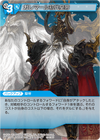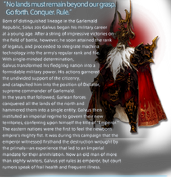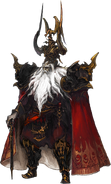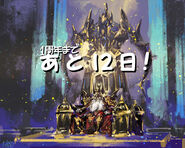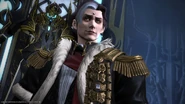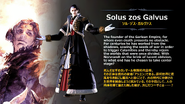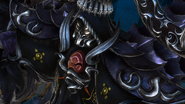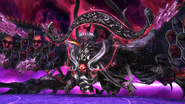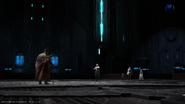Template:Sideicon
No lands must remain beyond our grasp. Go forth. Conquer. Rule.
Solus zos Galvus quoting his imperial mandate.
Emet-Selch is a non-playable character in Final Fantasy XIV. He is an Ascian working to bring about the Rejoining. Resurfacing in Final Fantasy XIV: Stormblood with a younger, more able body, Emet-Selch would go on to become the main antagonist of Shadowbringers.
Emet-Selch's best-known persona was Solus zos Galvus, the founder and first Emperor of the Garlean Empire, and the grandfather of Varis zos Galvus and great-grandfather of Zenos yae Galvus. As the Legatus and later Emperor, Solus was a visionary and brilliant leader who dreamed of a glorious future for his people. He forged an empire in the span of a single generation, but his vision led to war and expansion, the Garleans conquering nation after nation under the pretense of "uplifting" them and ending the threat of the primals. The Garleans oppressing the imperial provinces led to fear, anger and resentment towards the Empire. Despite this prominent role, Solus was never depicted in the flesh on screen. He is briefly shown as a false memory in Cid Garlonds recollection of the events at Bojza Citadel.
History
Early life
Born as one of the few ancients with the gift of "soul sight", the man known as Hades was chosen to fill the seat of Emet-Selch for the Convocation of Fourteen, a group that served as guardians of the city of Amaurot and the world. Hades was good friends with two other ancients: Hythlodaeus, another ancient with soul sight and the Chief of the Bureau of the Architect; and his fellow convocation member filling the seat of Azem. Falling into despair when their world was besieged by a calamity from within, Hades joined his fellow Convocation members and devised a plan to halt the calamity: summon the will of the planet, the primal Zodiark. The price to accomplish this feat would be grave, and caused Azem to leave in dissent. Half of their people were sacrificed to offer up the necessary aether to complete the ritual.
Upon Zodiark's creation, the deity enthralled Hades and the others into becoming his devout followers, but succeeded in his primary purpose. Even with the Final Days halted, the world was still unfit for nurturing life, so the Convocation besought their people to sacrifice another half of their number to replenish their ruined world and restore the cycle of nature. For Hades and the Convocation to restore the lives of those originally sacrificed, Zodiark would require even more aether; aether that would come from the new life being born into the world. This disturbed Venat, who felt that the sacrificial costs were already too great, and that the world now belonged to the lives birthed in it. An opposing group of Amaurotians who felt similarly thus summoned Hydaelyn in opposition to Zodiark, and the resulting conflict ended with Hydaelyn's final attack shattering reality, sundering the world and nearly all life on it into the Source and its thirteen shards.
Hades survived the Sundering intact along with two of his fellow Convocation members, Lahabrea and Elidibus, while everything he knew and loved was either sacrificed to Zodiark, or fragmented into what they consider flawed parodies. Going by his title Emet-Selch, Hades worked with the other Paragons and their Ascian followers to orchestrate the Rejoining of the shards with the Source to restore both their god and their home. During the Source's Third Astral Age, Emet-Selch influenced the creation of the Allagan Empire by helping its advancement until it was destroyed in the Fourth Umbral Calamity. During that time, he inducted the Allagan scientist Amon into the Ascians while restoring his memories as the Convocation member Fandaniel.
Establishing the Garlean Empire
The Garlean Solus zos Galvus was born in the year 1489 of the Sixth Astral Era to the esteemed House Galvus, a distinguished family of pureblood Garleans in the then-small Garlemald Republic. He joined the military at the age of sixteen, where he distinguished himself from the rank and file as a brilliant tactician and statesman and attained the rank of Legatus by his twenty-fourth nameday in 1513.[2] At some point before the founding of the Garlean Empire Emet-Selch took over Solus's body who would control it for the rest of his life, but the exact timeframe of the possession is unknown.
Shortly after achieving the rank of Legatus, Solus learned of the newly-invented ceruleum engine and saw its combat potential as he guided the development of magitek weapons and its integration into the army.[2] Despite initial skepticism, the Garleans saw Solus's reasoning as it allowed them to conquer northern Ilsabard and won over the subjugated peoples with the promise their lives would be improved with magitek.
In 1517, Solus was granted control of Garlemald as dictator by popular support. Garlemald devastated the small country of Nhalmasque before conquering the south of Ilsabard in 1522. Solus proclaimed himself Emperor, and created the Garlean Empire.[2] In spite of Solus's many successes it is difficult to characterize his life as happy: he was betrayed by those he had believed were his closest friends, and lost his firstborn son to illness when the man was still young.[2]
Expanding the Empire
Solus was not content with Ilsabard alone. Six years after becoming Emperor, he set his gaze upon the eastern continent of Othard. With their warmachina at the fore, the Imperial forces toppled all who dared stand before them. During this campaign the Emperor laid eyes upon the ruin wrought by primals—an entire land drained of life. The sight led him to issue a mandate for the annihilation of the dread beings the Garleans dubbed "eikons" to deny them as beings of divine origin.
After a long and hard-fought resistance, the nation of Doma fell to Garlemald in 1552. Having conquered the east, the Emperor turned his armies towards the west, plotting the invasion of Aldenard, and captured Ala Mhigo in 1557. However, this was to be the last victory for some time.[2]
Final Fantasy XIV legacy
Once Ala Mhigo had been assimilated into the Empire both politically and economically, the XIVth Imperial Legion focused on hastening the progress of the Eorzean campaign. In 1562, the Imperial fleet accompanied by the mighty flagship Agrius forged its way into Mor Dhona and to Silvertear Falls. The legion's armada encountered unexpected resistance from the Midgardsormr—forgotten guardian deity of the lake. The great dragon called out to his kin, who pitted themselves against the Garleans' fleet. The battle ended when Midgardsormr and the Agrius collided and plummeted to the land, compelling the legion to retreat from Mor Dhona.
The Ascians teaching Eorzea's beast tribes the means of summoning their own "gods" provided the Emperor the means of motivating the Empire to conquer Eorzea.[3]
The Garleans attempted communication with the lesser moon Dalamud under the guidance of the Empire's principal engineer and grand minister of industry, Midas nan Garlond. Dubbed "Project Meteor" the operation was tested at the Imperial stronghold of Bozja Citadel using Allagan artifacts donated by House Darnus. The project was proposed by nan Garlond after the Emperor had tasked the engineer with finding a solution to the eikon threat. Nan Garlond uncovered the Allagans' method of overcoming primals and that Dalamud was an ancient satellite the Allagans had created. He surmised that within the moon's metallic nacelle slumbered a great source of untapped energy—forgotten power that could transform the moon into a weapon of mass destruction if pulled down from the skies and unleashed upon Eorzea. The moon was to serve as the Empire's own "meteor".
Days after receiving the Emperor's blessing, nan Garlond traveled to the Garlean city of Bozja to communicate with Dalamud. The immensity of the satellite's power was confirmed, but nearly five millennia-worth of amassed energy was directed to the citadel's makeshift transmission tower, evaporating the tower as well as the city. The Imperial Censors tried to hide the event, but the vanishing of a major commercial center was too big a secret to suppress. News of the catastrophe spread across Hydaelyn and became known as the Bozja Incident.
The loss of Midas nan Garlond, the lunar transmitter, and the Allagan records stored at the Bozja Citadel, seemingly ended Project Meteor. The Emperor had no interest in power of such an unpredictable nature and ordered the project to be dismantled.[4]
During the Empire's decade-long stalemate with Eorzea, the Emperor publicly recognized Legatus Nael van Darnus as a man of exceptional talent for his crucial victories in the Empire's eastern campaign. Despite being well past his eightieth nameday by the year 1572, Solus's ambitions to unify the Three Great Continents under Garlean rule were as strong as ever. After amalgamating the political affairs of the occupied territories in Othard, he once again set his sights upon Aldenard and her vexing eikons. When he declared the eikons' annihilation as one of his administration's top priorities, van Darnus proposed ridding Eorzea of its false gods once and for all using House Darnus's closely guarded knowledge of Allagan relics to succeed where others had failed.[5]
After learning of his deployment to Eorzea, van Darnus convinced the Emperor into resurrecting Project Meteor, claiming he had discovered a means to control Dalamud. After a decade-long stalemate on the Eorzean front, the aged Emperor, impatient to solidify his legacy before his death, entertained the notion of a realm-wide "cleansing" of beastmen and their eikons and the second phase of Project Meteor was commenced.[4]
In spite of repeated interference from the Grand Companies and adventurers, Project Meteor went along with the lesser moon beginning its descent into a direct collision course with Eorzea. With the denizens of Eorzea praying to their gods, the remnants of the VIIth Imperial Legion amassed at the plains of Carteneau where Dalamud was expected to make landfall. The Eorzean Alliance learned of this thanks to Gaius van Baelsar, Legatus of the XIVth Imperial Legion, who disagreed with Project Meteor.[6]
Eorzea was devastated as Dalamud shattered above the land to reveal the elder primal Bahamut, who was subjugated by the Archon Louisoix Leveilleur[7] and the Seventh Umbral Era was subverted. Gaius and his XIVth Legion used Eorzea's state of disarray to set up several outposts across the land in preparation for the future conquest of the severely weakened realm.[8]
Final Fantasy XIV: A Realm Reborn
Five years after the Calamity, Solus remains the official ruler, but decides to make his exit via letting his corporeal form die of old age. News of the Emperor's failing health incite political strife within the Empire over who would succeed him, leading to the official abandonment of the unified effort to conquer Eorzea with only Gaius and his legion attempting to conquer the realm on their own.
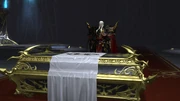
Galvus's casket being spat upon by the succeeding Emperor.
Not long after the beginning of the Seventh Astral Era, Emet-Selch discards his human façade by succumbing to an ailment at the age of eighty-eight. As Gaius is no longer present to oppose any challengers, a civil war breaks out in Garlemald over the succession to the throne.[2] The conflict is resolved with Solus's grandson Varis zos Galvus named Emperor, learning the truth of his grandfather's true nature while commissioning the use of Allagan technology to create clones of Solus.
Final Fantasy XIV: Stormblood
The founding father was an Ascian! And he created the Empire solely for the purpose of sowing the seeds of chaos! Don't take it personally. I merely do my duty.
Solus zos Galvus

Solus's cloned body.
The Ascian Emissary Elidibus is forced to bring Emet-Selch back as Solus some time after Lahabrea's demise. Emet-Selch finds the cloned bodies of his previous vessel preferable to possessing a random body and molding it in his image. With his return, Solus becomes the power behind the throne with Varis serving as a figurehead, much to his dismay. Solus reminds Varis that he is not to make judgments but to administer them without question, as any threats to the balance of the Light and Dark are to be expunged. He reveals that he, as an Ascian, built the Garlean Empire for the purpose of creating chaos and to ultimately invoke another Calamity. Varis shoots him, proclaiming that man is the master of his own destiny. His attempt is scoffed off as Solus simply reappears in another clone body to end their discussion.
Following Gaius and Alphinaud Leveilleur destroying the plant manufacturing the Black Rose gas, Solus notes its application could be useful for his agenda. He uses what he considers his final meeting with Varis to thank him for the clone bodies. Following the siege of Ala Mhigo reaching a stalemate, the Elidibus wishes to speak with Solus, but neither he nor Varis know where he is, Varis remarking he could be doing what all Ascians do. Elidibus suspects that Solus has found a means to take advantage of the situation.
Final Fantasy XIV: Shadowbringers
Well, well, we have a historian in our midst. That spares me a lengthy explanation. I am Solus zos Galvus, founding father of the Garlean Empire. And, under various guises, the architect of myriad other imperially inclined nations. As for my true identity... I am Emet-Selch. Ascian.
Emet-Selch
Emet-Selch, having arrived on the First, one of the shards of the Source, some time prior, follows the Warrior of Light when they make their own appearance. He possesses a vessel he molded into his preferred appearance while observing the Scions' actions from afar. He makes his presence known after Titania's defeat, introducing himself by his Ascian title: Emet-Selch. While admitting he is tempted to ally with Eulmore, he offers cooperation with the Scions despite Urianger Augurelt destroying a shade he was using to offer the deal.
Later, when the Warrior of Light, Urianger, Thancred Waters, and Minfilia arrive in the Rak'tika Greatwood, Emet-Selch reiterates his proposal to join the group as an observer, to which the Scions begrudgingly accept. He disappears again after being trapped by the Night's Blessed, reappearing to win the group's trust by retrieving Y'shtola Rhul after she used Flow to escape a pit at the Ronkan ruins. After the Scions defeat Eros, they find ancient murals depicting the Sundering, the event that shattered the original world. Emet-Selch reveals the Ascians' origins from that world, and that Hydaelyn and Zodiark are primals. Emet-Selch justifies the Ascians' actions by saying that as all the races of man are but fragments of their true selves, the Ascians do not consider them people.
Emet-Selch remains as an observer until the Warrior of Light fails to contain the amassed light of Norvrandt's Lightwardens, revealing he has been testing the Warrior and the Scions to see if the former would regain enough of their "former self" to be considered a potential ally. He spirits the Crystal Exarch away after he is revealed to be G'raha Tia for his knowledge of magic to transport between reflections and back in time, and requests the Warrior to meet him in a recreation of the original world where they can be consumed by the light in peace. He is disappointed that the Warrior arrives with the Scions. Emet-Selch reveals the Ascians' intent to sacrifice the lesser beings once Zodiark is freed, as in his opinion the people of the Source and its shards are unworthy inheritors of the reunited world. When Alphinaud posits they are not different in their resolve, Emet-Selch takes offense and forces them through another trial in the form of a recreation of the calamity that befell his world.
Even now, after everything, you refuse to see reason. You think it unfair that you are subject to suffering? That your lives will be sacrificed for the ancients? Look at me! I have lived a thousand, thousand of your lives! I have broken bread with you, fought with you, grown ill, grown old! Sired children and yes, welcomed death's sweet embrace. For eons have I measured your worth and found you wanting! Too weak and feeble-minded to serve as stewards of any star!
Emet-Selch confronting the Scions
Despite the Scions fighting their way to him, Emet-Selch remains unconvinced of their worthiness and defeats them, while gloating that the Warrior will be consumed by the light. When the Warrior stabilizes after fully merging their soul with Ardbert—the leader of the First’s Warriors of Light—Emet-Selch briefly sees an familiar Amaurotian before denouncing the vision in anger. Emet-Selch is livid when G'raha Tia arrives to aid the Warrior with reinforcements, and decides to face the Warrior in a final test, revealing his true name: Hades. Though initially gaining the upper hand, the Warrior of Light unleashes the collected Light within them to overpower Hades's Darkness. Overwhelmed despite channeling his kin's collective power, Hades refuses to surrender and is only defeated when the Scions use white auracite to hold him at bay long enough for the Warrior of Light to kill him with an aetheric blade in the form of Ardbert's axe. Hades accepts his death, asking the Warrior of Light to remember their people before fading away with a smile.
Remember...remember us... Remember...that we once lived...
Emet-Selch's final words
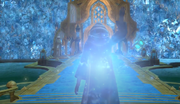
Emet-Selch's final walk.
The Warrior of Light later acquires a crystal that Emet-Selch secretly created with memories and the powers of the fourteenth member of the Convocation, Azem.[9] It allows use of Azem's personal magic, the summoning of allies in direst need. A shade in the recreation of Amaurot implies that Emet-Selch would not want the final unsundered, Elidibus, to be left alone after his passing. During the Warrior's battle with Elidibus who takes on the form of the original Warrior of Light, Emet-Selch appears in ancient guise and summons the party back from the void with a snap of his fingers. He saunters away with a final wave to Elidibus.
Characteristics
Appearance
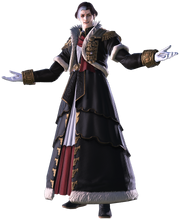
Emet-Selch.
As an old man Solus zos Galvus has a long white beard. He wears full body armor and the Garlean crown, and uses a walking cane.
His younger form has yellow eyes and burgundy hair with a white streak. He wears a stylish black military coat adorned with gold on the chest and white fur along the trimmings. He wears white gloves.
Solus's true identity is that of Emet-Selch, an Ascian, whose true name is Hades. Like his brethren, Emet-Selch has an Ascian mark, though more sinister and infernal in design compared to his Paragon comrades. He rarely wears the Ascians' black robes since taking the vessel of Solus zos Galvus. Hades's final form resembles the Esper Zodiark's second form in Final Fantasy XII. Emet-Selch is the only Ascian thus far encountered to be seen without the typical Ascian red mask. In his "Tales from the Shadows" side story, Emet-Selch's original form was the typical form of an Amaroutine as a tall humanoid with white hair. Like all members of the Convocation, he wore a distinct red mask.
Personality
Emperor Solus was said to be an enthusiastic theater-goer and patron of the arts. He commissioned the building of an airship for the Majestic Imperial Theater Company so they could travel the realm and bring their performances to the far reaches of the Empire. This hearkens to the Tantalus Theater Troupe from Final Fantasy IX.
Solus, or Emet-Selch by his Ascian name or Hades by his true name, is more eccentric and talkative than the average Ascian, being unpredictable and condescending towards his allies. His eccentricities often leave those around him exasperated or enraged. He remains convinced of the importance of the balance between Light and Dark and considers the original form of man the definition of perfection while viewing the "broken" races mere parodies of his kin, to the point he does not consider their deaths murder. He extends this contempt to his mortal grandson, Varis, having no interest in the Empire outside its intended purpose of spreading chaos. His resentment towards Varis also stems from him resembling his firstborn son, whose death serves as a final reminder of mortal imperfection in Emet-Selch's eyes. However, he does show interest in certain mortals who underwent the Umbral Calamity numerous times on the Source, and are thus closer to completion. He believes that those of the Source are superior to the "halflings" of the other shards.
Emet-Selch is a loner, and though he operates with full intention to bring about the Rejoining, his actions are often considered unpredictable. Beneath his eccentricity and cheerfulness, Emet-Selch bears the burden of centuries of sorrow and pain over all that he and his people have lost, and a burning hatred for Hydaelyn and all who fight in Her name. In contrast to the maniacal scheming of Lahabrea and the cold rationality of Elidibus, Emet-Selch is the only member of the unsundered to retain his sense of self over the ages and expresses deep melancholy over Amaurot's fall. Whenever he speaks his true feelings, his voice deepens and becomes more gravely.
Unlike the other Ascians, Emet-Selch appears to have a distaste for lies and overt deceptions. While he often omits information in his dealings, or stays mum when he could be more forthcoming, he never contradicts his word. He considers deceitfulness beneath him, since his wealth of knowledge across eons means that anyone he speaks with cannot discern a lie of his from the truth anyway. This trait may allude to the title of Final Fantasy XII's Scion of Light of the same name: "Angel of Truth".
Gameplay
Hades.
Hades is fought as the final boss of Shadowbringers in The Dying Gasp. An optional Extreme trial, The Minstrel's Ballad: Hades's Elegy, was added in patch 5.1.
Every boss in Shadowbringers has its name and a title shown in the pre-fight cutscene, such as "Lightwarden". The only exception is Hades, who tells the Warrior to "cast titles aside" and fight right before the battle commences.
Other appearances
Final Fantasy Trading Card Game
The Emperor appears with an ice-elemental card.
Behind the scenes
Design

Artwork.
Emet-Selch's character was designed by Natsuko Ishikawa, and drew inspiration from Jack Sparrow from the Pirates of the Caribbean series with the goal of adding more human elements on top of his character. The team tried to work around the character's resemblance to Ardyn Izunia from Final Fantasy XV so they wouldn't overlap too much.[10]
Allusions
Just before the player unlocks the final dungeon of Shadowbringers, Emet-Selch walks into the hall of fire in a similar way to Sephiroth in the Nibelheim burning scene in Final Fantasy VII. This is the second time Final Fantasy XIV alludes this scene after Nael van Darnus's scene in Castrum Novum in the original version.
There are allusions to his real name "Hades", the first being his ability to retrieve Y'shtola from the First's lifestream, and later channeling the spirits of his fallen Ascian kin during his boss fight. The gate he opens to a dungeon recreating the end days of his world alludes to the Gates of Hell. The penultimate boss is named Therion, a hell beast mentioned in the Book of Revelation. Additionally, Hades is remarkable in Amaurot for being capable of sensing and controlling a portion of the "Underworld", the aetherial realm where the souls of the dead rejoin, mirroring the mythological Hades's dominion over the realm of the dead.
Gallery
Etymology
The Latin word solus means "alone" or "separate" and is commonly used in stage directions. "Galvus" is derived from Latvian word galva, meaning "head".
"Emet-Selch" refers to the light scion "Emet-Selch, Angel of Truth" referred to in the profile of Zalera in Final Fantasy XII. His glyph mask, before fighting him as Hades, is almost identical to the bottom portion of Zalera's, only inverted.
Emet-Selch in Hebrew is אמת–סלח (emet-selaḥ). Formed out of two root words (Hebrew shoreshim, "roots" are the three-letter combinations from which all other words are derived), the words themselves cannot be reduced any further and are in their "whole" or "original" forms, just as Emet-Selch, one of the Source Ascians, is of his "original" form. אמת is "truth", while סלח is the verbal "to forgive", making the literal translation of the title "(to) forgive the truth".
Hades (ᾍδης, Hā́idēs) is the Greek god of the underworld, as well as the name of the underworld itself. Despite many modern portrayals, in ancient Greek religion and mythology, though respected and feared in equal measure, Hades was not represented as evil, only just and resolute. In Christianity, the same Greek name is either translated into English as Hell or simply transliterated as "Hades" in the Bible. The Greek term is used to translate the Hebrew term Sheol in almost all instances in the Septuagint and appears in the New Testament. Emet-Selch's connection to the Greek god, Hades, is further solidified in the "Through His Eyes" short story, where he is described as having an affinity with the "Underworld", the ancients' term for the Lifestream.
References
- ↑ Benjo (n.d.) . Gamescom 2019 Q&A (rough transcript). Final Fantasy XIV official forums. Archived from the original on 1 September, 2019.
- ↑ 2.0 2.1 2.2 2.3 2.4 2.5 Encyclopedia Eorzea, p. 177-178
- ↑ Encyclopedia Eorzea, p. 38
- ↑ 4.0 4.1 Encyclopedia Eorzea, p. 41
- ↑ Encyclopedia Eorzea, p. 40
- ↑ Encyclopedia Eorzea, p. 42, 43
- ↑ Encyclopedia Eorzea, p. 44, 45
- ↑ Encyclopedia Eorzea, p. 54
- ↑ Final Fantasy XIV, Patch 5.3
- ↑ Giuseppe Nelva (n.d.) . Final Fantasy XIV Interview: Naoki Yoshida Discusses the Future of Square Enix's Popular MMORPG. Twinfinite. Archived from the original on 4 August, 2021.

